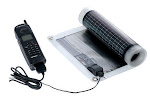
DETROIT (CNNMoney.com) -- The applause hasn't died down for the new Chevrolet Volt, but General Motors is already planning where the technology for this new electric car can go next.
The Volt, which made its official debut Tuesday, is based on what GM calls the "E-Flex platform." This new type of vehicle uses high-capacity lithium-ion batteries and will be able to go up to 40 miles on a full charge. If a driver wants to go farther, the car's small gasoline engine will generate more electricity, allowing trips of over 300 miles.
But that technology doesn't have to stop with the Volt, according to said Tony Posawatz, vehicle line director for the E-Flex program. Different body styles - wagons or small cars, for instance - and versions styled for different brands are under consideration for a future, improved E-Flex use.
"These are some of the alternatives that are being reviewed, even as we speak, relative to the future beyond Volt," Posawatz said in an interview with CNNMoney.com after the Volt's official unveiling in Detroit Tuesday.
He made it clear, though, that any discussions of E-Flex's future are preliminary. No decisions have been made, but lots of options are on the table.
It's not too soon for GM to be thinking about this, either, said Bill Pochiluk of the auto industry consulting firm AutomotiveCompass. Transferring the technology won't be that hard, he said.
"Some of the systems and modules will be directly transferable to other vehicles," according to Pochiluk. Add to that a much more competitive hybrid electric car market by the time the Volt comes out, he said.
By the summer of 2009, Pochiluk sees Honda and Toyota still dominating the market. But GM will move fast, he predicted, becoming the third biggest hybrid vehicle manufacturer with no one else even close.
Flexing E-Flex
As with any other vehicle platform, different body styles could easily be built on top of the Volt's engineering. In the same way that the Chevy Cobalt car and HHR wagon are basically the same vehicle underneath while looking completely different, GM could easily put different "top hats," as they're called in the industry, on the E-Flex platform.
That would be an easy first step to extending the E-Flex's market in different directions, Posawatz said. There are already indications that there could be an appetite.
"It's grown beyond our wildest imaginations, the degree to which people connected to the idea of the car, the spirit of the car," Posawatz said. "That's given us a degree of confidence that this could be a family of vehicles in the future."
Creating the Volt meant engineers had to clear the big hurdles the first time out.
But when you build an electric car that doesn't have to compromise on utility or performance, Posawatz noted, "it's easier taking it in different directions."
The E-Flex powertrain, which is the car's engine and electric motor, works well in a mid-size sedan carrying four passengers and cargo, so it has the flexibility to accommodate more or less demand for different vehicles, Posawatz said.
"This has a little bit of bandwidth," Posawatz said. "This can go on a little bit bigger vehicle if necessary." And it can be scaled down to create more economical versions, he said. With a smaller battery pack, a vehicle might not go as far without needing gasoline. But it would also cost a lot less, an appealing proposition to some.
"There are a number of customers out there that maybe a 20-mile [electric-only range] vehicle would work, and they would still use little to no petroleum," said Posawatz.
All in on electric
Forgoing the gasoline engine altogether for a shorter-range car is another possibility, Posawatz said, but it's one that creates problems.
First of all, it just goes against the whole idea of E-Flex. GM believes there's less of a market for a limited-use vehicle. Why wouldn't customers want the option (even if they rarely use it) of driving a car farther than batteries alone will take them?
Pochiluk agreed that all-electric cars just aren't as attractive from a marketing standpoint. People will always be scared of getting stranded. "I think it's impossible to go without a range extender when you've only got 40 miles," he said.
Another problem is that electric only operation is harder on a vehicle's battery, according to Posawatz. Repeatedly draining a battery down to near zero, will mean much shorter battery lives, he said.
"We're only cycling it to a 50% state of charge," with the E-Flex platform, said Posawatz, "so we're not beating the crap out of the battery."
For an automaker with the scope of General Motors, different branding creates many opportunities for the range-extended E-Flex. There will probably be E-Flex vehicles that aren't Chevrolets. No doubt, Cadillac, Pontiac, Saturn and other GM dealers would love to get their own plug-in vehicles to sell.
But for now, Posawatz is concentrating on just getting the ball in play. "You always have to do the first car right and well." 























 Imagine a six-inch spy plane that sends back visual and chemical data in real time, runs on vibrations as well as sun and wind power - and looks like a bat! Thanks to a five-year $10-million grant from the Army the University of Michigan College of Engineering will be making this Batman wet dream a reality. The renewable robot will be developed at U-M’s newly created Center for Objective Microelectronics and Biomimetic Advanced Technology a mouthful also appropriately known as COM-BAT. The University of Michigan will work with the University of California at Berkley as well as the University of New Mexico to create different aspects of the technology.
Imagine a six-inch spy plane that sends back visual and chemical data in real time, runs on vibrations as well as sun and wind power - and looks like a bat! Thanks to a five-year $10-million grant from the Army the University of Michigan College of Engineering will be making this Batman wet dream a reality. The renewable robot will be developed at U-M’s newly created Center for Objective Microelectronics and Biomimetic Advanced Technology a mouthful also appropriately known as COM-BAT. The University of Michigan will work with the University of California at Berkley as well as the University of New Mexico to create different aspects of the technology.










































